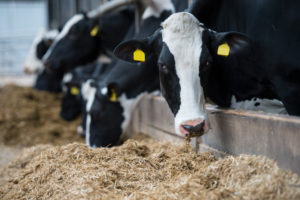When nutrients are broken down in the rumen they produce gases which is necessary, but also an inefficient use of valuable nutrients. As an animals nutrient requirement increases, rumen bacteria alone are unable to cope with the increased requirements, therefore by-passing nutrients into the hindgut offer both additional nutrients but also less gas production and therefore more efficient use of feed nutrients.
So why should I feed protected feeds?
1. Improved performance – UK diets based on grass silages and homegrown cereals tend to be higher in rumen degradable nutrients. By-pass energy and protein are then required to supply the nutrients above and beyond what is capable of rumen bacteria. A lack of bypass nutrients can often be seen in cows not achieving their peak yields.
2. Rumen available nutrients – Grass silages this season have been analysing very well. Oversupplying nutrients to the rumen can create a challenging environment for bacteria, therefore supplying by-pass nutrients is not only more efficient but essential for rumen health.
3. Environmental responsibilities – Feeding excessive protein can be detrimental to both the cows’ health (due to negative energy balance) and the environment due to higher urea nitrogen levels. Feeding by-pass protein can enable farmers to reach metabolizable protein requirements whilst feeding less overall crude protein and therefore reducing waste and cost.

What are my options?
Most usual protein sources such as rapeseed meal, distillers and soya contain both rumen degradable and by-pass protein. The same can also be said for starch, where cereals also contain both rumen degradable and by-pass starch. The key question is for every kilogram of a raw material that’s fed, how many grams of by-pass protein or starch is supplied. This can be expressed as the amount of metabolizable protein from by-pass (MPB) or the amount of by-pass starch (BPS).
What are the NWF protected feeds and how do they become more by-pass?
NWF Agriculture has been manufacturing unique and high quality protected feeds for over 10 years under the ’Ultra’ brand. The three products consist of Ultra Pro R (protected rapeseed meal), Ultra Soy (protected soya) and Ultra Starch W (protected wheat). Using a protected treatment unique to NWF Agriculture in GB and widely used across Europe and the US and regularly tested to ensure their compliance with health and safety needs are met, the ‘Ultra’ brand of protected feeds offer a strong and consistent option for maximising performance both physically and financially.
Whilst offering the same amount of energy and starch as wheat, Ultra Starch W allows higher intakes to be achieved with a significantly reduced risk of causing acidosis. This is because more of the starch is protected and passed through to the hindgut. This benefits rumen health and nutrient utilisation. Where 24% of starch from wheat reaches the hindgut and 28% from caustic wheat, 42% of starch from Ultra Starch W passes through, offering strong competition to maize.
The same principle is applied to Ultra Pro R and Ultra Soy where the approximate amount of by-pass protein in rapeseed meal is 30% but increases to 76% in Ultra Pro R, and soya at 39% by-pass is increased to 84% in Ultra Soy. This offers both nutritional and financial benefits. By supplying more by-pass protein through Ultra Pro R and Ultra Soy, lower levels of overall protein can be fed which offers both animal health and environmental benefits.
For more information on the NWF Protected Feeds range, click HERE or call our commodities manager, Rupert, on 01829 262 270.
